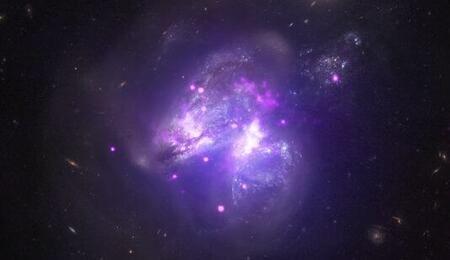When galaxies collide: Cool NASA photo shows galactic 'goulash'

Ever wondered what happens when galaxies "collide?"
Now we know, thanks to a cool image from NASA's Chandra X-ray Observatory. The image of "Arp 299," which was released Monday, is a composite of visible light and X-ray light.
[caption id="attachment_5113" align="alignnone" width="300"] Arp 299, located some 140 million lightyears from earth, contains two galaxies that are merging. (Photo:Chandra X-ray Observatory Center)[/caption]
In the image, X-rays are represented with pink and blue colors, while visible light is red, green, and blue.
Arp 299 is located about 140 million light years from Earth and contains two galaxies that have been merging for millions of years, creating a blended mix of stars from each galaxy in the process.
It's also one of the most powerful star-forming galaxies in the nearby universe, NASA said. This is due in part to the merger of the two galaxies, which has triggered waves of star formation.
Arp 299, located some 140 million lightyears from earth, contains two galaxies that are merging. (Photo:Chandra X-ray Observatory Center)[/caption]
In the image, X-rays are represented with pink and blue colors, while visible light is red, green, and blue.
Arp 299 is located about 140 million light years from Earth and contains two galaxies that have been merging for millions of years, creating a blended mix of stars from each galaxy in the process.
It's also one of the most powerful star-forming galaxies in the nearby universe, NASA said. This is due in part to the merger of the two galaxies, which has triggered waves of star formation.

 Arp 299, located some 140 million lightyears from earth, contains two galaxies that are merging. (Photo:Chandra X-ray Observatory Center)[/caption]
In the image, X-rays are represented with pink and blue colors, while visible light is red, green, and blue.
Arp 299 is located about 140 million light years from Earth and contains two galaxies that have been merging for millions of years, creating a blended mix of stars from each galaxy in the process.
It's also one of the most powerful star-forming galaxies in the nearby universe, NASA said. This is due in part to the merger of the two galaxies, which has triggered waves of star formation.
Arp 299, located some 140 million lightyears from earth, contains two galaxies that are merging. (Photo:Chandra X-ray Observatory Center)[/caption]
In the image, X-rays are represented with pink and blue colors, while visible light is red, green, and blue.
Arp 299 is located about 140 million light years from Earth and contains two galaxies that have been merging for millions of years, creating a blended mix of stars from each galaxy in the process.
It's also one of the most powerful star-forming galaxies in the nearby universe, NASA said. This is due in part to the merger of the two galaxies, which has triggered waves of star formation.

The Chandra telescope is in orbit around the Earth at a distance about 1/3 of the way to the moon. (Photo: NASA)Chandra Observatory has detected over a dozen objects in Arp 299 that give off large amounts of x-rays, which NASA believes are either neutron stars or black holes. Launched in 1999 and now in orbit around the Earth, the Chandra Observatory is s a telescope specially designed to detect X-ray emissions from very hot regions of the universe. SOURCE USA TODAY
S
Soft Secrets



